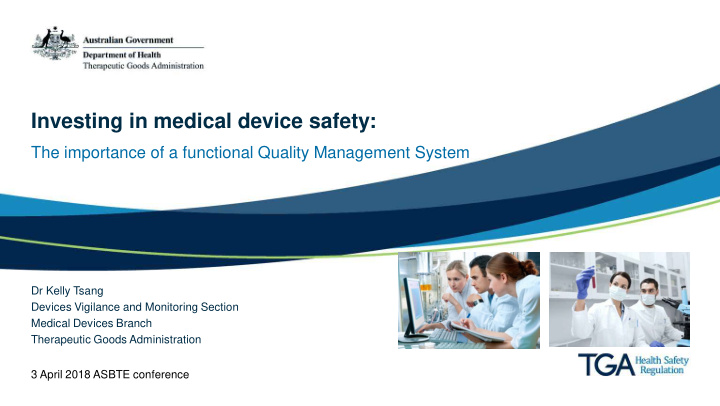



Investing in medical device safety: The importance of a functional Quality Management System Dr Kelly Tsang Devices Vigilance and Monitoring Section Medical Devices Branch Therapeutic Goods Administration 3 April 2018 ASBTE conference
Therapeutic Goods Administration (TGA) • Part of the Australian Government Department of Health • Australian regulator for medicines, medical devices and products of biological origin • Regulatory decisions based on the Therapeutic Goods Act 1989 • Balancing industry and public healthcare needs • ‘Better health and wellbeing for all Australians through regulatory excellence’ 1
Bench to bedside to brand Good Brand Good Products Good QMS Research R&D Science Death and Injury 2
Medical device incident report (DIR) analytics Number of Reports • Over 5000 DIRs reported each year 6000 – Incidents can lead to death or serious injury, or 5000 potential for injury 4000 3000 – Known complications account for 41% of issues 2000 – Most others are rooted in QMS upon investigation 1000 Cause of incident 0 2011 2012 2013 2014 2015 2016 2017 2018 Known Complication Year Manufacturing process Breakdown of incidents 2014-2017 Mechanical problem Not Known Electrical No Injury Other Software Temporary Injury Quality system deficiency Serious Injury Labelling Death Biological 3 0 1000 2000 3000 4000 5000 6000
Quality management system (QMS) • Long term investment- research, validation, post market monitoring • Benefits and risks may stay with the patient forever • QMS- protect your investment by ensuring quality- controlling processes and products • Ensuring all products conform and meet quality requirements • Investing in quality by controlling product and processes – Note Australian clinical context may be different from other countries – Think about the country in which the product is marketed and use the correct models 4
Having a QMS is only the beginning • ISO 13485 Medical devices —QMS — Requirements for regulatory purposes • Post-market is the real test of QMS – a living system • Common QMS deficiencies: – QMS not updated, not revisited after first production Decline in product/ batch quality Trends not recognised in time – QMS not triggered adequately when incident occurs Incidents not reported to TGA Insufficient investigation Limited corrective and preventive action • TGA involvement to ensure device safety 5
When things go wrong • Lets manufacturer investigate and implement changes • TGA gets involved when we think there’s insufficient clarity or action • Review documentation, stats, results of investigation Failure Mode and Effect Analysis (FMEA) Risk assessment documents (SRA, HHE) Corrective And Preventive Action (CAPA) • Is the QMS functioning? Have the right QMS processes been triggered? Have the correct root causes been determined and is it reasonable? Are corrective and preventive measures appropriate? Was appropriate recall action taken to eliminate the issue? Did the device comply with all relevant Essential Principles? 6
Case study • Patient monitoring device (ECG)- lack of audio • TGA had questions on: alarms when patient develops critical condition – amount of testing performed on speakers • Caused by early failure of speaker component – appropriateness of test conditions • TGA noticed increased rate of failures over time – appropriateness of CAPA procedures • Manufacturer investigated in 2012 and – appropriateness of health hazard evaluation improved design – extent of recall action taken • Improvement was not rolled out to older units • TGA intervention led to which were kept in service – recall of susceptible units Number of Reports Culmulative frequency – review and ongoing improvements in company QMS 120 100 80 60 40 20 0 2011 2012 2013 2014 2015 2016 2017 7 Year
Take home message • Medical device manufacturing is a significant, long term development that can have a big impact on people’s lives • Invest in quality and listen to engineers • Look after the QMS and keep it active Next TGA session- Tania Ahmed Wed 16:55 Rottnest room Regulation of High-risk Medical Devices in Australia from a Biomaterials Perspective 8
Recommend
More recommend